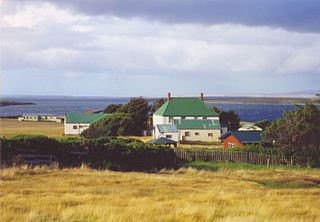 W
WTussock grasses or bunch grasses are a group of grass species in the family Poaceae. They usually grow as singular plants in clumps, tufts, hummocks, or bunches, rather than forming a sod or lawn, in meadows, grasslands, and prairies. As perennial plants, most species live more than one season. Tussock grasses are often found as forage in pastures and ornamental grasses in gardens.
 W
WAchnatherum calamagrostis is a species of grass known by the common names spear grass, needle grass, and silver spike grass. It is an ornamental grass native to the clearings in the mountains of central and southern Europe, which grows in mounds of blue-green leaves and long, silvery plumes.
 W
WAgropyron cristatum, the crested wheat grass, crested wheatgrass, fairway crested wheat grass, is a species in the family Poaceae. This plant is often used as forage and erosion control. It is well known as a widespread introduced species on the prairies of the United States and Canada.
 W
WAgropyron fragile is a plant species in the family Poaceae.
 W
WAgropyron pungens, the sea couch grass, is a species of grass of the genus Agropyron in the family Poaceae. It is a common grass species native to Europe and Asia. Agropyron pungens is typically found in sandy, and saline environments and can tolerate harsh weather conditions; because of this it is a common pioneer species typically associated with sand dunes.
 W
WAlopecurus aequalis is a common species of grass known as shortawn foxtail or orange foxtail. It is native to much of the temperate Northern Hemisphere from Eurasia to North America, where it can be found in many types of habitat.
 W
WAlopecurus arundinaceus, the creeping meadow foxtail or creeping foxtail, is a rhizomatous perennial species in the Grass family (Poaceae). Native to Eurasia and northern Africa, and widely introduced elsewhere, this sod forming grass is useful as a forage and for erosion control. It grows in damp or saline grasslands and banks of waterways, and on mountains up to 1,200 m. It flowers between April and July, depending on its location.
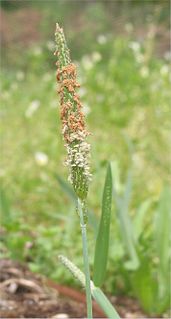 W
WAlopecurus geniculatus is a species of grass known by the common name water foxtail or marsh foxtail. It is native to much of Eurasia and introduced into North America, South America, and Australia. It grows in moist areas.
 W
WAlopecurus pratensis, known as the meadow foxtail or the field meadow foxtail, is a perennial grass belonging to the grass family (Poaceae). It is native to Europe and Asia.
 W
WAmpelodesmos is a genus of Mediterranean plants in the grass family, which is known by the common names stramma, Mauritania grass, rope grass, and dis grass. It is classified in its own tribe Ampelodesmeae within the grass subfamily Pooideae.
 W
WBeckmannia eruciformis, the European slough-grass or slough grass, is an annual or short lived perennial in the grass family, Poaceae, found in shallow marshes or sloughs, and used for animal fodder and forage.
 W
WBrachypodium sylvaticum, commonly known as false-brome, slender false brome or wood false brome, is a perennial grass native to Europe, Asia and Africa. It has a broad native range stretching from North Africa to Eurasia.
 W
WBriza maxima is a species of the grass genus Briza. It is native to Northern Africa, the Azores, Western Asia, and Southern Europe and is cultivated or naturalised in the British Isles, Australasia, the western United States, Central and South America, and Hawaii.
 W
WBromus arvensis, the field brome, is a brome grass native to Europe and Asia. The specific epithet arvensis is Latin, meaning "of cultivated land".
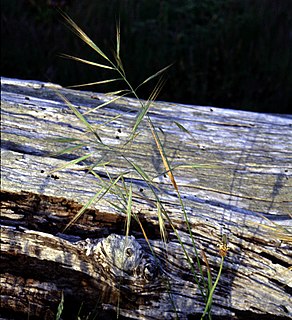 W
WBromus diandrus is a species of grass known by the common names great brome and "ripgut brome".
 W
WBromus inermis is a species of the true grass family (Poaceae). This rhizomatous grass is native to Europe.
 W
WBromus ramosus, the hairy brome, is a bunchgrass in the grass family Poaceae, native to Europe, northwest Africa and southwest Asia. The name Bromus comes from the term brome, meaning oats. Unlike most other bromes, it grows in shady sites under trees.
 W
WBromus sterilis is an annual or biennial species of bromegrass known as barren brome, poverty brome, and sterile brome.
 W
WBromus tectorum, known as downy brome, drooping brome or cheatgrass, is a winter annual grass native to Europe, southwestern Asia, and northern Africa, but has become invasive in many other areas. It now is present in most of Europe, southern Russia, Japan, South Africa, Australia, New Zealand, Iceland, Greenland, North America and Asia. In the eastern US B. tectorum is common along roadsides and as a crop weed, but usually does not dominate an ecosystem. It has become a dominant species in the Intermountain West and parts of Canada, and displays especially invasive behavior in the sagebrush steppe ecosystems where it has been listed as noxious weed. B. tectorum often enters the site in an area that has been disturbed, and then quickly expands into the surrounding area through its rapid growth and prolific seed production.
 W
WCeltica gigantea, commonly called giant feather grass, giant needle grass, or golden oats, is a bunchgrass in the genus Celtica, native to southern Europe. It occurs in Spain and other Mediterranean countries. It is still widely referenced in the horticultural literature under its synonym Stipa gigantea.
 W
WChrysopogon gryllus is a perennial bunchgrass of the family Poaceae, native to Europe and tropical and temperate Asia.
 W
WCynosurus echinatus is a species of grass known by the common names bristly dogstail grass, rough dog's-tail and hedgehog dogtail. It is native to southern Europe, and it is known in the Americas and Australia as an introduced species and sometimes a noxious weed. An herbicide-resistant strain can be found growing as a weed in canola and wheat fields in Chile. This is an annual grass growing 10 to 50 centimeters tall. The inflorescence is a rounded or oval cluster or series of clusters of spikelets. The fertile spikelet has an awn up to a centimeter long. The awns clumped closely together into a tuft gives the inflorescence its bristly, hairy appearance.
 W
WDactylis is a genus of Eurasian and North African plants in the bluegrass subfamily within the grass family. They are known in English as cock's-foot or cocksfoot grasses, also sometimes as orchard grasses.
 W
WDactylis glomerata, also known as cock's-foot, orchard grass, or cat grass (due to its popularity for use with domestic cats) is a common species of grass in the genus Dactylis. It is a cool-season perennial C3 bunchgrass native throughout most of Europe, temperate Asia, and northern Africa.
 W
WDanthonia decumbens is a species of grass commonly known as the heath grass, heath-grass, or staggers grass It is a tussock grass native to Europe and adjacent parts of Asia and North Africa. It may also be native to Newfoundland and Nova Scotia.
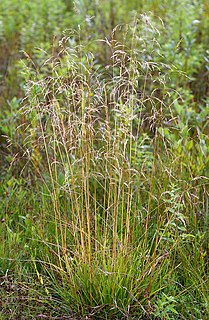 W
WDeschampsia cespitosa, commonly known as tufted hairgrass or tussock grass, is a perennial tufted plant in the grass family Poaceae. Distribution of this species is widespread including the eastern and western coasts of North America, parts of South America, Eurasia and Australia.
 W
WDeschampsia flexuosa, commonly known as wavy hair-grass, is a species of bunchgrass in the grass family widely distributed in Eurasia, Africa, South America, and North America.
 W
WEragrostis cilianensis is a species of grass known by several common names, including stinkgrass, candy grass, and gray lovegrass.
 W
WEragrostis pilosa is a species of grass. It is native to Eurasia and Africa. It may or may not be native to North America. It is widely introduced, and it is a common weed in many areas.
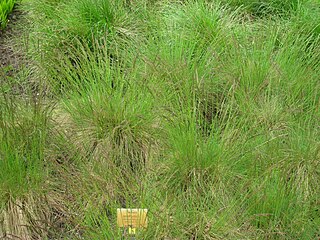 W
WFestuca amethystina is a species of true grass (Poaceae) native to Europe, including Turkey.
 W
WFestuca arundinacea (syn., Schedonorus arundinaceus and Lolium arundinaceum) is a species of grass commonly known as tall fescue. It is a cool-season perennial C3 species of bunchgrass native to Europe. It is an important forage grass throughout Europe, and many cultivars have been used in agriculture. It is also an ornamental grass in gardens, and a phytoremediation plant.
 W
WFestuca glauca, commonly known as blue fescue, is a species of flowering plant in the grass family, Poaceae. It is a commonly cultivated evergreen or semi-evergreen herbaceous perennial.
 W
WFestuca polesica is a species of grass, a perennial bunchgrass native to the sand dunes of northern Europe.
 W
WFestuca pratensis, the meadow fescue, is a perennial species of grass, which is often used as an ornamental grass in gardens, and is also an important forage crop.
 W
WHelictotrichon, or alpine oatgrass, is a genus of perennial flowering plants in the grass family. Genus name comes from the Greek heliktos meaning twisted and trichos meaning spine, referring to the shape of the awn.
 W
WHelictotrichon sempervirens, the blue oat grass, is a species of flowering plant in the true grass family, Poaceae, native to central and southwest European grasslands. It is a bunchgrass often used as an ornamental grass in garden design and landscaping.
 W
WHordeum murinum, commonly known as wall barley or false barley, is a species of grass.
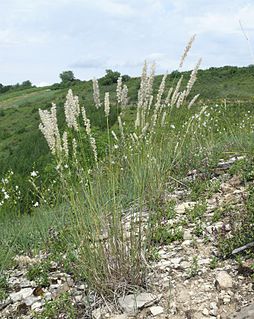 W
WMelica ciliata, the hairy melic or silky spike melic, is a species of perennial bunchgrass native to Europe, north Africa, and temperate Asia. It has been introduced to South Australia.
 W
WMibora, or sandgrass, is a genus of European and North African plants in the grass family.
 W
WMolinia, or moor grass, is a genus of two species of flowering plants in the grass family, native to damp moorland in Eurasia and northern Africa. They are both herbaceous perennial grasses.
 W
WMolinia caerulea, known by the common name purple moor-grass, is a species of grass that is native to Europe, west Asia, and north Africa. It grows in locations from the lowlands up to 2,300 m (7,546 ft) in the Alps. Like most grasses, it grows best in acid soils, ideally pH values of between 3.5 and 5, however, it can continue to live under more extreme conditions, sometimes to as low as 2. It is common on moist heathland, bogs and moorland throughout Britain and Ireland. Introduced populations exist in northeastern and northwestern North America.
 W
WParapholis incurva is a species of grass native to Europe, Asia and northern Africa, and widely naturalised elsewhere. Common names include coast barbgrass, curved sea hard grass, curved hard-grass, sicklegrass, curved sicklegrass and curved parapholis.
 W
WPhalaris arundinacea, or reed canary grass, is a tall, perennial bunchgrass that commonly forms extensive single-species stands along the margins of lakes and streams and in wet open areas, with a wide distribution in Europe, Asia, northern Africa and North America. Other common names for the plant include gardener's-garters in English, alpiste roseau in French, rohrglanzgras in German, kusa-yoshi in Japanese, caniço-malhado in Portuguese, and hierba cinta and pasto cinto in Spanish.
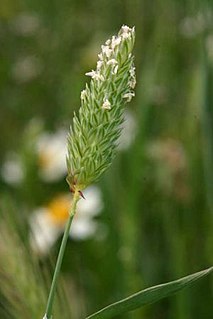 W
WPhalaris minor is a species of grass native to North Africa, Europe, and South Asia. The bunchgrass is widely naturalised elsewhere.
 W
WTimothy is an abundant perennial grass native to most of Europe except for the Mediterranean region. It is also known as timothy'-grass, meadow cat's-tail or common cat's tail. It is a member of the genus Phleum, consisting of about 15 species of annual and perennial grasses.
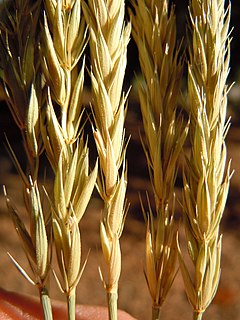 W
WPsathyrostachys juncea is a species of grass known by the common name Russian wildrye. It was formerly classified as Elymus junceus. It is native to Russia and China, and has been introduced to other parts of the world, such as Canada and the United States. Psathyrostachys juncea is a great source of food for grazing animals, as it has high nutrition value in its dense basal leaves, even in the late summer and autumn seasons. This species can grow and prosper in many harsh environments, making it an ideal candidate for improvement as it can grow in areas were farming is difficult. This species is a drought-resistant forage plant and can survive during the cool seasons. It is also a cross-pollinator and is self-sterile. This means that P. juncea cannot self-fertilize; it must find another plant of the same species with which to exchange gametes. Self-sterilization increases the genetic diversity of a species.
 W
WSetaria verticillata is a species of grass known by the common names hooked bristlegrass, rough bristle-grass and bristly foxtail. It is native to Europe, but it is known on most continents as an introduced species and often a noxious weed. It is a hardy bunchgrass which grows in many types of urban, cultivated, and disturbed habitat. It is a weed of many types of agricultural crops, growing in vineyards and fields. Herbicide-resistant strains have been noted.
 W
WStipa barbata is a species of perennial grass native to southern Europe, North Africa, and the Levant in the Mediterranean Basin, and temperate Asia.
 W
WStipa borysthenica is a perennial bunchgrass species in the family Poaceae, native to Europe and Asia.
 W
WStipa capillata is a perennial bunchgrass species in the family Poaceae, native to Europe and Asia.
 W
WStipa tenacissima is a perennial grass of northwestern Africa and the southern part of the Iberian Peninsula.
 W
WStipa tirsa is a species of perennial grass native to Europe and temperate Asia. Culms are 40–100 cm long; leaf blades are filiform, involute, and 1–2 mm wide.
 W
WTimothy is an abundant perennial grass native to most of Europe except for the Mediterranean region. It is also known as timothy'-grass, meadow cat's-tail or common cat's tail. It is a member of the genus Phleum, consisting of about 15 species of annual and perennial grasses.
 W
WTrisetum flavescens, the yellow oatgrass or golden oat grass, is a species of grass in the family Poaceae. It is native to Europe, Asia, and North Africa.